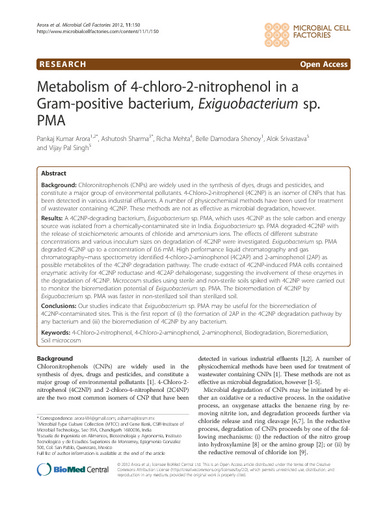| dc.contributor.author | Arora, Pankaj K. | en |
| dc.contributor.author | Sharma, Ashutosh | en |
| dc.contributor.author | Mehta, Richa | en |
| dc.contributor.author | Shenoy, Belle D. | en |
| dc.contributor.author | Srivastava, Alok | en |
| dc.contributor.author | Singh, Vijay P. | en |
| dc.date.accessioned | 2016-06-20T03:51:29Z | |
| dc.date.available | 2016-06-20T03:51:29Z | |
| dc.date.issued | 21/11/2012 | |
| dc.identifier.other | Microbial Cell Factories. 2012 Nov 21;11(1):150 | |
| dc.identifier.uri | http://dx.doi.org/10.1186/1475-2859-11-150 | |
| dc.identifier.uri | http://hdl.handle.net/11285/613664 | |
| dc.description.abstract | Abstract Background Chloronitrophenols (CNPs) are widely used in the synthesis of dyes, drugs and pesticides, and constitute a major group of environmental pollutants. 4-Chloro-2-nitrophenol (4C2NP) is an isomer of CNPs that has been detected in various industrial effluents. A number of physicochemical methods have been used for treatment of wastewater containing 4C2NP. These methods are not as effective as microbial degradation, however. Results A 4C2NP-degrading bacterium, Exiguobacterium sp. PMA, which uses 4C2NP as the sole carbon and energy source was isolated from a chemically-contaminated site in India. Exiguobacterium sp. PMA degraded 4C2NP with the release of stoichiometeric amounts of chloride and ammonium ions. The effects of different substrate concentrations and various inoculum sizes on degradation of 4C2NP were investigated. Exiguobacterium sp. PMA degraded 4C2NP up to a concentration of 0.6 mM. High performance liquid chromatography and gas chromatography–mass spectrometry identified 4-chloro-2-aminophenol (4C2AP) and 2-aminophenol (2AP) as possible metabolites of the 4C2NP degradation pathway. The crude extract of 4C2NP-induced PMA cells contained enzymatic activity for 4C2NP reductase and 4C2AP dehalogenase, suggesting the involvement of these enzymes in the degradation of 4C2NP. Microcosm studies using sterile and non-sterile soils spiked with 4C2NP were carried out to monitor the bioremediation potential of Exiguobacterium sp. PMA. The bioremediation of 4C2NP by Exiguobacterium sp. PMA was faster in non-sterilized soil than sterilized soil. Conclusions Our studies indicate that Exiguobacterium sp. PMA may be useful for the bioremediation of 4C2NP-contaminated sites. This is the first report of (i) the formation of 2AP in the 4C2NP degradation pathway by any bacterium and (iii) the bioremediation of 4C2NP by any bacterium. | |
| dc.language.iso | eng | en |
| dc.publisher | Open Access Publisher | en |
| dc.relation.url | http://microbialcellfactories.biomedcentral.com/articles/10.1186/1475-2859-11-150 | en |
| dc.rights.uri | http://creativecommons.org/licenses/by-nc-nd/4.0/ | * |
| dc.title | Metabolism of 4-chloro-2-nitrophenol in a Gram-positive bacterium, Exiguobacterium sp. PMA | en |
| dc.type | Artículo / Article | en |
| dc.contributor.department | Tecnologico de Monterrey | en |
| dc.rights.holder | Arora et al.; licensee BioMed Central Ltd. | |
| dc.date.updated | 2016-06-01T12:18:49Z | |
| dc.subject.keyword | 4-Chloro-2-nitrophenol | en |
| dc.subject.keyword | 4-Chloro-2-aminophenol | en |
| dc.subject.keyword | 2-aminophenol | en |
| dc.subject.keyword | Biodegradation | en |
| dc.subject.keyword | Bioremediation | en |
| dc.subject.keyword | Soil microcosm | en |
| dc.subject.discipline | Ciencias de la Salud / Health Sciences | |
| refterms.dateFOA | 2018-03-18T19:01:29Z | |
| html.description.abstract | Abstract Background Chloronitrophenols (CNPs) are widely used in the synthesis of dyes, drugs and pesticides, and constitute a major group of environmental pollutants. 4-Chloro-2-nitrophenol (4C2NP) is an isomer of CNPs that has been detected in various industrial effluents. A number of physicochemical methods have been used for treatment of wastewater containing 4C2NP. These methods are not as effective as microbial degradation, however. Results A 4C2NP-degrading bacterium, Exiguobacterium sp. PMA, which uses 4C2NP as the sole carbon and energy source was isolated from a chemically-contaminated site in India. Exiguobacterium sp. PMA degraded 4C2NP with the release of stoichiometeric amounts of chloride and ammonium ions. The effects of different substrate concentrations and various inoculum sizes on degradation of 4C2NP were investigated. Exiguobacterium sp. PMA degraded 4C2NP up to a concentration of 0.6 mM. High performance liquid chromatography and gas chromatography–mass spectrometry identified 4-chloro-2-aminophenol (4C2AP) and 2-aminophenol (2AP) as possible metabolites of the 4C2NP degradation pathway. The crude extract of 4C2NP-induced PMA cells contained enzymatic activity for 4C2NP reductase and 4C2AP dehalogenase, suggesting the involvement of these enzymes in the degradation of 4C2NP. Microcosm studies using sterile and non-sterile soils spiked with 4C2NP were carried out to monitor the bioremediation potential of Exiguobacterium sp. PMA. The bioremediation of 4C2NP by Exiguobacterium sp. PMA was faster in non-sterilized soil than sterilized soil. Conclusions Our studies indicate that Exiguobacterium sp. PMA may be useful for the bioremediation of 4C2NP-contaminated sites. This is the first report of (i) the formation of 2AP in the 4C2NP degradation pathway by any bacterium and (iii) the bioremediation of 4C2NP by any bacterium. | |

